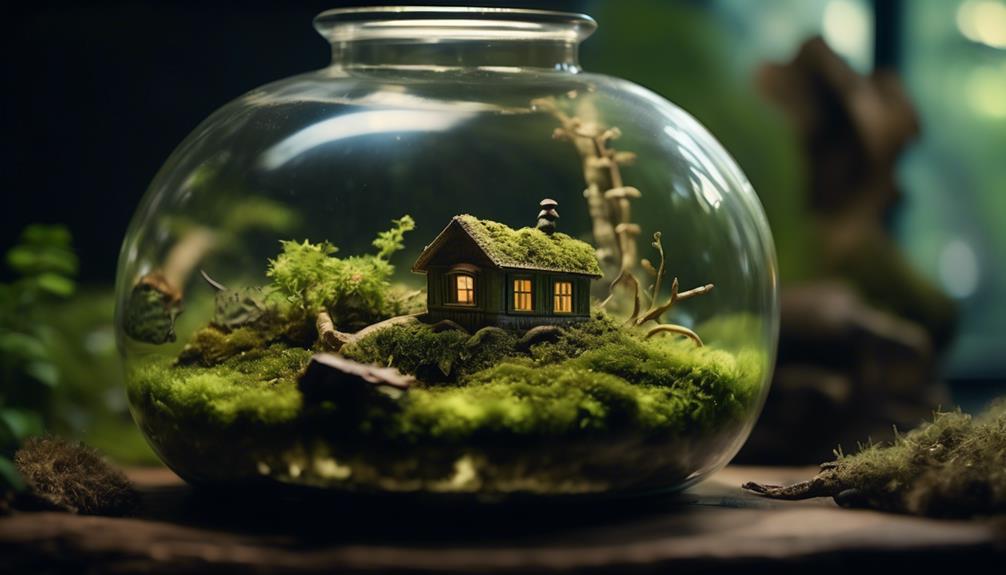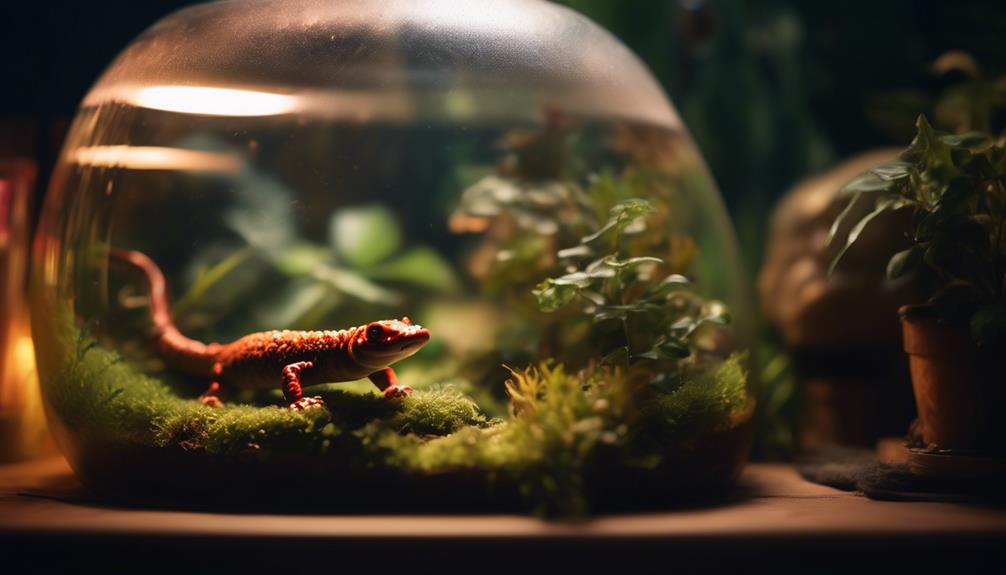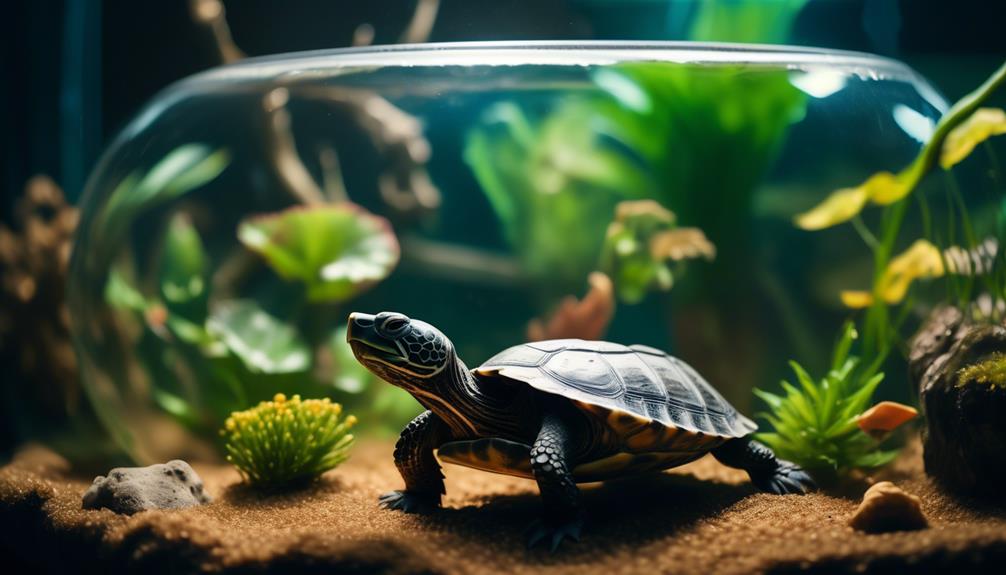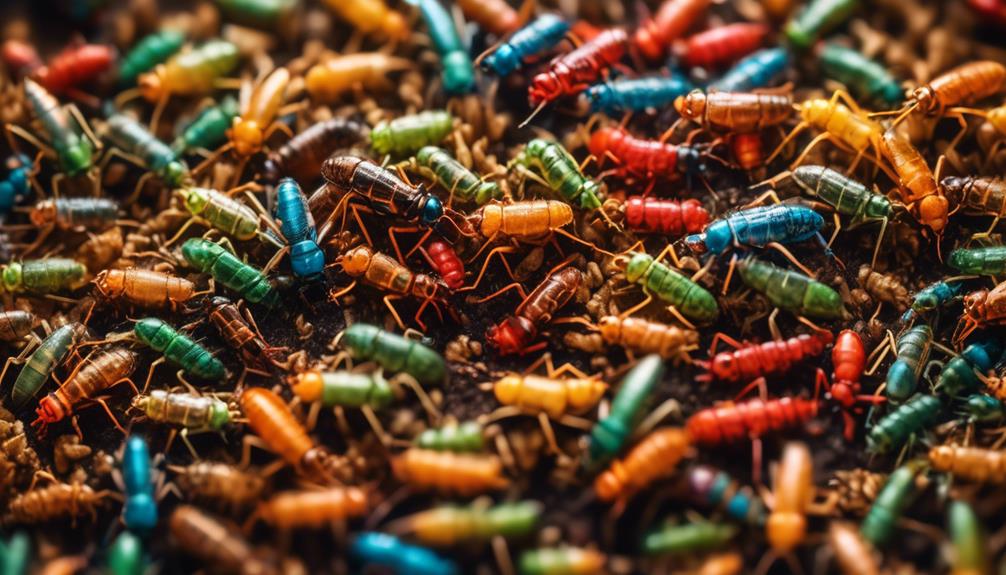As we stumbled upon the world of spotted salamander care, we couldn't help but be captivated by the complexity and intricacy of their needs.
It's fascinating how these creatures thrive in their unique habitats, and we are here to guide you through the essential aspects of providing them with the perfect care.
From the ideal enclosure size and lighting requirements to temperature and humidity levels, we will uncover the secrets to creating a comfortable and healthy environment for your spotted salamander.
But that's not all; there's much more to discover, so keep reading to unveil the keys to mastering spotted salamander care.
Key Takeaways
- Spotted salamanders should be housed in a minimum enclosure size of 30L x 12W x 12H or a 20 gallon long tank, with a front-opening enclosure being recommended for easier maintenance.
- Spotted salamanders are solitary and should not be housed together.
- Providing hiding spots with leaf litter, fallen logs, and debris is important for their well-being.
- It is recommended to avoid taking spotted salamanders from the wild and instead purchase them from a breeder.
Housing Requirements

When considering the housing requirements for spotted salamanders, it's essential to provide them with an appropriate enclosure size and suitable hiding spots. Choosing the right enclosure plays a crucial role in their well-being.
Spotted salamanders are solitary creatures and shouldn't be housed together, as this can lead to stress and aggression. A front-opening enclosure is highly recommended for easier maintenance. This type of enclosure allows for convenient access during feeding and cleaning, reducing the chances of escape.
Additionally, a front-opening enclosure provides a more naturalistic environment, mimicking the salamander's natural habitat. It also allows for better ventilation and airflow, which is important for maintaining proper temperature and humidity levels.
Lighting and Light Cycle
To ensure the optimal health and well-being of your spotted salamander, it's crucial to provide proper lighting and establish a suitable light cycle.
Choosing the right UVB bulb is essential for meeting their specific needs. We recommend using the Zoo Med Mini Compact Fluorescent Reptisun 5.0, 13w bulb, as it provides the necessary UVB rays. To maximize the effectiveness of the UVB bulb, it's important to set up a reflective fixture on top of the mesh lid. This will ensure that the UVB rays are properly directed towards the salamander.
It's important to replace the UVB bulb every 12 months to maintain its performance.
Additionally, establishing a consistent light cycle is key. During the summer, provide 14 hours of light per day, and during the winter, reduce the light cycle to 10 hours per day.
Temperature Requirements

Maintaining the proper temperature within the enclosure is crucial for the health and well-being of your spotted salamander. These amphibians are ectothermic, meaning they rely on external sources of heat to regulate their body temperature. To ensure that your salamander remains comfortable, it is important to provide a temperature range of 50-75°F. Temperatures exceeding 75°F can lead to heat stress and should be avoided. To accurately monitor the temperature, I recommend using digital probe thermometers. These devices provide precise temperature measurements and ensure that the conditions remain within the appropriate range. Heating equipment may not be necessary if your room temperature falls within the desired range. However, during the summer months, it is essential to maintain a consistently cool room if additional cooling is required.
| Heating Equipment | Temperature Measurement |
|---|---|
| Heat mat or heat lamp | Digital probe thermometers |
| Ceramic heat emitter | Infrared thermometers |
| Under-tank heating pad | Temperature gun |
Table 1: Recommended heating equipment and temperature measurement devices for spotted salamanders.
Humidity Levels
To ensure optimal conditions for your spotted salamander's well-being, it's crucial to maintain appropriate humidity levels within their enclosure. Spotted salamanders are highly susceptible to dehydration, so providing a humid environment is essential.
Aim for an average air humidity of 50-80%, which can be achieved by misting the enclosure 1-2 times daily with dechlorinated water. Regular misting helps prevent dehydration and keeps the salamander's skin moist, allowing for proper gas exchange.
Using a digital probe hygrometer to monitor humidity levels is recommended for accuracy. However, it's important not to provide a pool of water in the enclosure, as this can lead to excessive moisture and potential health issues for the salamander.
Substrate Options

After addressing the importance of maintaining appropriate humidity levels for spotted salamanders, we now turn our attention to exploring the various options available for substrate within their enclosure. The substrate plays a crucial role in providing a comfortable and natural habitat for these amphibians. It should be moisture-retentive, have small particles, and hold moisture well. Here are some alternative substrate options for spotted salamanders:
| Substrate | Benefits |
|---|---|
| Zoo Med ReptiSoil | Retains moisture, promotes burrowing behavior |
| Zoo Med Eco Earth | Holds moisture, provides a soft and natural environment |
| Exo Terra Plantation Soil | Supports plant growth, enhances visual appeal |
These substrates not only meet the necessary requirements but also offer additional benefits. Live plants can be incorporated into the enclosure, providing the salamanders with hiding spots and a more visually appealing environment. The presence of live plants also helps maintain humidity levels and improves air quality. When using live plants, it is important to ensure that they are non-toxic to the salamanders and can withstand the moisture and temperature conditions of the enclosure. Regular maintenance, such as removing waste daily and replacing the substrate every 2 months, ensures a clean and healthy habitat for your spotted salamanders.
Frequently Asked Questions
Can Spotted Salamanders Be Kept Together in the Same Enclosure?
No, spotted salamanders should not be kept together in the same enclosure. They are solitary creatures and prefer to live alone. This is important to consider when creating a natural habitat for them.
How Often Should the UVB Bulb Be Replaced?
We should replace the UVB bulb for spotted salamanders every 12 months to ensure optimal performance. To maximize their lifespan, we recommend using moisture-retentive substrates like Zoo Med ReptiSoil or Eco Earth.
What Is the Ideal Temperature Range for Spotted Salamanders?
The ideal temperature range for spotted salamanders is between 50-75°F. It's crucial to avoid exceeding 75°F to prevent heat stress. Maintaining a cool room during summer, if necessary, ensures a comfortable environment for these amphibians.
Should a Heat Source Be Provided in the Enclosure?
Yes, a heat source should be provided in the enclosure for spotted salamanders. A heat mat is a beneficial option, as it creates a warm spot for thermoregulation. Other methods include ceramic heat emitters and low-wattage heat bulbs.
Can Tap Water Be Used to Mist the Enclosure, or Should It Be Treated With a Water Conditioner?
Yes, tap water should be treated with an amphibian-safe water conditioner before misting the enclosure. This ensures the removal of harmful chemicals and provides a safer environment for the spotted salamander.
Conclusion
In conclusion, providing proper care for your spotted salamander is crucial for their health and well-being. By following the guidelines outlined in this ultimate guide, you can create a comfortable and thriving habitat for your salamander.
For example, let's imagine a case study where a salamander named Spot was kept in an ideal enclosure with the right temperature, humidity, lighting, and substrate. Spot thrived in this environment, displaying vibrant colors and a strong appetite, ultimately living a long and healthy life.
Remember, attention to detail and understanding of their specific needs are key to perfect spotted salamander care.


